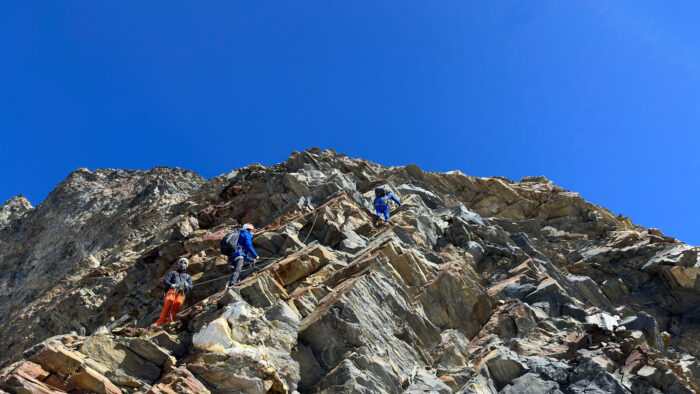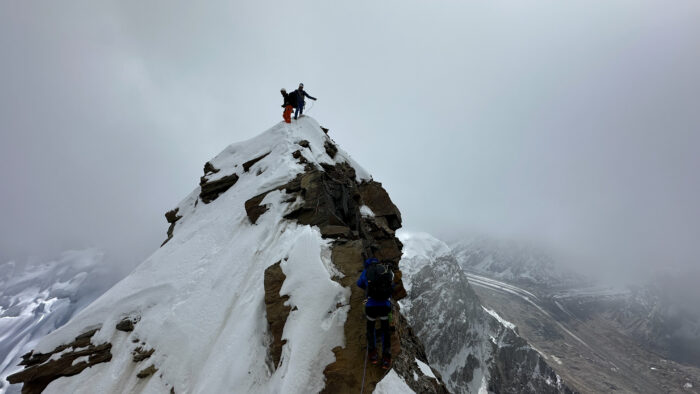Stefan Siegrist and Jonas Schild of Switzerland returned to India’s Garhwal Himalaya recently for a third attempt on 6,540m Shivling. As often happens with alpine-style teams, they ended up opening a new route on a different peak instead — the southwest ridge of Bhagirathi III.
“You can make a great ascent even if things don’t go as planned,” Schild admitted.
Siegrist and Schild first tried Shivling in 2021 but aborted due to health problems. The following year, a late monsoon burdened the mountain with tons of snow.
“We couldn’t even approach the peak due to the high risk of avalanches,” Schild explained.
Shivling stays elusive
This time, despite heavy rains that delayed their trek in, the weather improved quickly. Siegrist and Schild, accompanied by Hugo and Kaspar Grossniklaus, reached base camp in good time. They immediately went up for a three-day acclimatization trip and prepared for the final push.
“The whole team was in excellent health, the weather was stable, and the conditions on the mountain got better every day,” Siegrist reported.

When the climb up on Shivling still looked bright. Photo: Stefan Siegrist
The first two days went well, and they had reason to hope. On the first day, they climbed a rocky pillar to a first camp at 5,700m. Very early the following day, they continued up in great conditions.
“The climbing was perfect, the cracks ideal,” Schild recalled. “This time, I free-climbed the crux section, which I had only managed with aid in 2021. Pure climbing fun at around 6,000m!”
He also noted that the route had changed dramatically since their last attempt. In particular, he mentioned a dihedral that does not exist anymore. (See photo below.)

Schild climbs a pitch that used to be a dihedral. Photo: Stefan Siegrist
Then, at dinnertime, things suddenly went south. Kaspar Grossniklaus fell ill with high-altitude pulmonary edema in Camp 2 at 6,100m.
“Stef and I looked at each other in disbelief,” Schild wrote. “It was the same story, the same place, and the same elevation as our first attempt in 2021. We had to abort 400m below the summit and rappel down.”
A ready alternative
The climbers were not ready to return home empty-handed. With Kaspar Grossniklaus recovered, they embraced a Plan B that was right in front of them: the southwest ridge of 6,454m Bhagirathi III. They had studied the potential line from base camp, just a football field away. It was an obvious alternative.

On the way to Camp 1 on Bhagirathi III. Photo: Stefan Siegrist
“Only four days after our return from Shivling, we set off, crossing the Gangotri Glacier and climbing up to 5,600m,” Schild wrote. “We found an incredibly beautiful bivouac site and spent a cold night in the tent.”
The following morning, they passed the snowfield leading to the ridge, which was totally on rock — poor rock, actually. The climbers described it as a band of dark, brittle rock that makes up the upper part of the Bhagirathi group and is notorious for its fragility.

Loose rock on the ridge. Photo: Stefan Siegrist
Rotten rock techniques
Schild noted that the difficulty was UIAA 4th or 5th grade, but the biggest challenge was finding solid holds and places to put protection.
Schild told ExplorersWeb that they secured themselves with Friends or by passing a rope around a rocky outcrop, as they did back in the Swiss Alps when guiding clients. He and Siegrist are IFMGA guides, and the method he describes is very common in the Alps, including on the Matterhorn.
“For me, this is the safest when climbing on loose, brittle rock,” he explained.
Carefully but steadily, the four of them progressed. “By lunchtime, we were happily hugging each other on the summit,” Schild recalled.

The summit ridge. Photo: Stefan Siegrist
For the descent, the team rappelled down the same route.
“To build safe anchors, we had to use our creativity, but with some pitons, beaks, and stoppers, we managed well and made it down in three or four rappels,” said Schild.

The route climbed on the SW ridge of Bhagirathi III. Photo: Swiss expedition team
No record of other climbs
The climbers are sure theirs was the first ascent of the southwest ridge.
“We have found no info on other climbs on the internet or from the Indian Mountain Federation,” they said. But they have also asked other climbers to contact them if they know anything to the contrary.
“In any case, it was an extremely valuable climb for our team after another disappointment on Shivling,” Schild noted.
This was the second time in a row that the Swiss climbers found a cool alternative after failure on Shivling. In 2022, the year that avalanche conditions were too high, they likewise found a perfect alternative. It was a 4,950m rock tower, which included a nose-like roof like on El Capitan, rising from the Kirti Glacier. The climbers called the route the Kirti Nose.
Shivling and the Bhagirathi massif lie in the heart of Garhwal Himalaya. It is a well-known spot for climbers, especially for Siegrist. Twenty years ago, he was a member of the team that made the first ascent of the northwest pillar of Thalay Sagar, also in the area.
Siegrist has climbed around the world but has a special affection for the North Face of the Eiger and for Patagonia, where he has led nearly 20 expeditions. He has often paired with Thomas Huber on new routes like Har Har Mahadev on Cerro Kishwar in 2017 in the Indian Himalaya. Siegrist also worked on the In Memoriam project, a new route with Thomas and Alex Huber on the Eiger North Face, and the first repetition of Jeff Lowe’s Metanoia.
Jonas Schild, born in 1992, is an IFMGA mountain guide specializing in high-level sport climbing, but also ice climbing in winter and trad routes on rock in summer.






